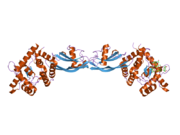From Wikipedia, the free encyclopedia
Protein-coding gene in the species Homo sapiens
GDNF family receptor alpha-3 (GFRα3 ), also known as the artemin receptorprotein that in humans is encoded by the GFRA3 gene .[ 5] [ 6]
The protein encoded by this gene is a glycosylphosphatidylinositol(GPI)-linked cell surface receptor and a member of the GDNF receptor family. It forms a signaling receptor complex with RET tyrosine kinase receptor and binds the artemin ligand .[ 6]
In mouse models of osteoarthritis , GFRα3 was upregulated in sensory nerves. Treating arthritic mice with monoclonal antibodies that bind to GFRα3 prevents artemin from binding there and signaling pain. Treated mice were able to use their limbs again two hours post-treatment.[ 7]
^ a b c GRCh38: Ensembl release 89: ENSG00000146013 – Ensembl , May 2017^ a b c GRCm38: Ensembl release 89: ENSMUSG00000024366 – Ensembl , May 2017^ "Human PubMed Reference:" . National Center for Biotechnology Information, U.S. National Library of Medicine .^ "Mouse PubMed Reference:" . National Center for Biotechnology Information, U.S. National Library of Medicine .^ Jing S, Yu Y, Fang M, Hu Z, Holst PL, Boone T, Delaney J, Schultz H, Zhou R, Fox GM (Dec 1997). "GFRalpha-2 and GFRalpha-3 are two new receptors for ligands of the GDNF family" . The Journal of Biological Chemistry . 272 (52): 33111–7. doi :10.1074/jbc.272.52.33111 PMID 9407096 . ^ a b "Entrez Gene: GFRA3 GDNF family receptor alpha 3" .^ Irving, Michael (2022-01-31). " . New Atlas . Retrieved 2022-02-01 .
Wang X, Baloh RH, Milbrandt J, Garcia KC (Jun 2006). "Structure of artemin complexed with its receptor GFRalpha3: convergent recognition of glial cell line-derived neurotrophic factors" . Structure . 14 (6): 1083–92. doi :10.1016/j.str.2006.05.010 PMID 16765900 . Zhang Z, Henzel WJ (October 2004). "Signal peptide prediction based on analysis of experimentally verified cleavage sites" . Protein Science . 13 (10): 2819–24. doi :10.1110/ps.04682504 . PMC 2286551 PMID 15340161 . Gimm O, Dziema H, Brown J, Hoang-Vu C, Hinze R, Dralle H, Mulligan LM, Eng C (Apr 2001). "Over-representation of a germline variant in the gene encoding RET co-receptor GFRalpha-1 but not GFRalpha-2 or GFRalpha-3 in cases with sporadic medullary thyroid carcinoma" . Oncogene . 20 (17): 2161–70. doi :10.1038/sj.onc.1204289 PMID 11360200 . Onochie CI, Korngut LM, Vanhorne JB, Myers SM, Michaud D, Mulligan LM (Sep 2000). "Characterisation of the human GFRalpha-3 locus and investigation of the gene in Hirschsprung disease" . Journal of Medical Genetics . 37 (9): 674–9. doi :10.1136/jmg.37.9.674 . PMC 1734691 PMID 10978357 . Baloh RH, Tansey MG, Lampe PA, Fahrner TJ, Enomoto H, Simburger KS, Leitner ML, Araki T, Johnson EM, Milbrandt J (December 1998). "Artemin, a novel member of the GDNF ligand family, supports peripheral and central neurons and signals through the GFRalpha3-RET receptor complex" . Neuron . 21 (6): 1291–302. doi :10.1016/S0896-6273(00)80649-2 PMID 9883723 . S2CID 18633359 . Baloh RH, Gorodinsky A, Golden JP, Tansey MG, Keck CL, Popescu NC, Johnson EM, Milbrandt J (May 1998). "GFRalpha3 is an orphan member of the GDNF/neurturin/persephin receptor family" . Proceedings of the National Academy of Sciences of the United States of America . 95 (10): 5801–6. Bibcode :1998PNAS...95.5801B . doi :10.1073/pnas.95.10.5801 PMC 20460 PMID 9576965 . Masure S, Cik M, Pangalos MN, Bonaventure P, Verhasselt P, Lesage AS, Leysen JE, Gordon RD (Feb 1998). "Molecular cloning, expression and tissue distribution of glial-cell-line-derived neurotrophic factor family receptor alpha-3 (GFRalpha-3)" . European Journal of Biochemistry . 251 (3): 622–30. doi :10.1046/j.1432-1327.1998.2510622.x PMID 9490034 . Robertson NG, Khetarpal U, Gutiérrez-Espeleta GA, Bieber FR, Morton CC (September 1994). "Isolation of novel and known genes from a human fetal cochlear cDNA library using subtractive hybridization and differential screening". Genomics . 23 (1): 42–50. doi :10.1006/geno.1994.1457 . PMID 7829101 .
Angiopoietin CNTF EGF (ErbB)
FGF
FGFR1 FGFR2
Agonists: Ersofermin FGF (1 , 2 (bFGF) , 3 , 4 , 5 , 6 , 7 (KGF ), 8 , 9 , 10 (KGF2) , 17 , 18 , 22 )Palifermin Repifermin Selpercatinib Sprifermin Trafermin FGFR3 FGFR4 Unsorted
HGF (c-Met) IGF
LNGF (p75NTR ) PDGF RET (GFL)
SCF (c-Kit) TGFβ Trk
TrkA
Negative allosteric modulators: VM-902A TrkB
Agonists: 3,7-DHF 3,7,8,2'-THF 4'-DMA-7,8-DHF 7,3'-DHF 7,8-DHF 7,8,2'-THF 7,8,3'-THF Amitriptyline BDNF BNN-20 Deoxygedunin Deprenyl Diosmetin DMAQ-B1 HIOC LM22A-4 N-Acetylserotonin NT-3 NT-4 Norwogonin (5,7,8-THF) R7 R13 TDP6 TrkC
VEGF Others
Additional growth factors: Adrenomedullin Colony-stimulating factors (see here instead)Connective tissue growth factor (CTGF) Ephrins (A1 , A2 , A3 , A4 , A5 , B1 , B2 , B3 )Erythropoietin (see here instead)Glucose-6-phosphate isomerase (GPI; PGI, PHI, AMF) Glia maturation factor (GMF) Hepatoma-derived growth factor (HDGF) Interleukins /T-cell growth factors (see here instead)Leukemia inhibitory factor (LIF) Macrophage-stimulating protein (MSP; HLP, HGFLP) Midkine (NEGF2) Migration-stimulating factor (MSF; PRG4) Oncomodulin Pituitary adenylate cyclase-activating peptide (PACAP) Pleiotrophin Renalase Thrombopoietin (see here instead)Wnt signaling proteins Additional growth factor receptor modulators: Cerebrolysin (neurotrophin mixture)







